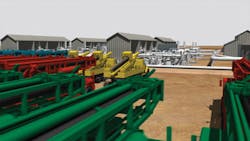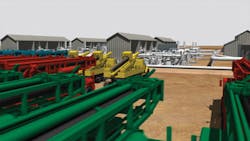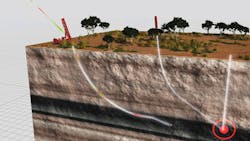Guntis Moritis
Production Editor
Royal Dutch Shell and its partner China National Petroleum Corp. (CNPC) are proceeding to build a well manufacturing system for high-density drilling to recover onshore hydrocarbon resources from such plays as coalbeds, tight sands, and shales.
Shell's plan calls for the system to be operating as early as 2013.
Business model
The system will change the business model for drilling wells by including machinery with a specific tasks and automation for eliminating some human elements that add costs and can cause errors, Peter Sharpe, executive vice-president of wells for Shell, explained in a recent presentation in Houston.
"With the number of wells Shell plans to drill, it is not possible to train and develop enough people for the jobs," Sharpe added.
He said Shell currently has plans to drill 435 wells in unconventional plays this year and about 30,000 wells through the decade.
As a reason to change the business model, Sharpe noted that Shell's Sakhalin Island project needed only 12 wells to supply gas to an LNG plant, whereas its Arrow coalbed methane project in Queensland, Australia, may require 10,000 wells to supply a similarly sized LNG plant.
Drilling costs in such ventures as Shell's Prelude floating LNG project off Australia and the Sakhalin project only represent about 10% of the total development costs, whereas they are the majority costs in unconventional resource development, he added.
Design
The planned system includes centralized production facilities for key logistics, such as drilling fluids and tubulars that will serve several wellsites at a time and highly automated truck-mounted rigs for specific tasks such as drilling the top hole, intermediate section, and completing the well (Fig. 1).
"The system will also decrease the drilling footprint at each wellsite compared with traditional set ups," Sharpe said. Shell and CNPC will collaborate on designing the equipment and most of it will be built by affiliates of CNPC. Their plan is to standardize the equipment for each field so that different plays will have different equipment designs.
The system also will include automated drilling and control with Shell's SCADAdrill that will replace such personnel as the directional driller, measure-while-drilling operator, and driller because algorithms combined with programmable logic controllers are much more reliable for simple wells, Sharpe said.
Automated drilling can reduce vibration and provide more control of the well trajectory, he explained.
Sharpe noted that intersecting wellbores will be much easier with an automated drilling system and that Shell plans to develop some fields with multiple intersecting wellbores (Fig. 3).
Shell has tested SCADAdrill on conventional rigs in the Netherlands, the Haynesville in Louisiana, the Marcellus in Pennsylvania, and Groundbirch in British Columbia.
In Groundbirch, according to a recent Shell presentation, the company plans to drill about 3,000 wells over 20 years to recover 6 tcf from Upper Montney microlaminated shales and siltstones that lie at a 2,200-3,000 m depth.
Other areas that Shell may use the well manufacturing system is on the extensive shale gas acreage it holds in China, the Grosmont carbonate heavy oil acreage in Alberta, and in the Middle East, Sharpe said.
More Oil & Gas Journal Current Issue Articles
More Oil & Gas Journal Archives Issue Articles
View Oil and Gas Articles on PennEnergy.com



